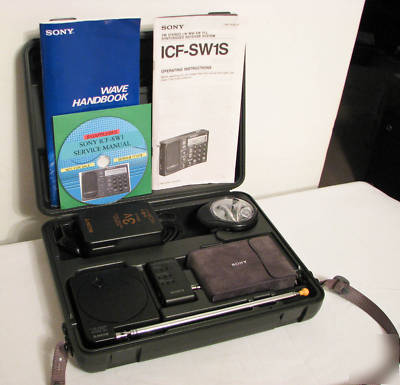Machine Parts For Reuse Newsgroup Discussion Forum > Small Size Parts
> New
> Sony icf-SW1 shortwave am fm travel dx radio receiver
Sony icf-SW1 shortwave am fm travel dx radio receiver
If this work is not done, you will soon or someday need to do it as all of these Sony SW1's will ultimately suffer from audio capacitor failure. It manifests itself as a motorboating sound when turning on the radio and when you are trying to hear a station. If you ever purchase one of these radios, you need to inquire of the seller if the caps have been replaced. The caps on this radio were quite bad and the audio was unintelligible. However, since the cap replacement, the audio sounds great and as it did originally when sold by Sony and likely will never need done again for the life of this unit.
I have taken a variety of pictures so that you can see both the uniqueness of this radio and all it's components. Everything on this SW1 works well and as designed by Sony. Cosmetics are excellent and the radio looks to be in outstanding condition overall.
This radio operates off of 2 AA batteries or the enclosed AC adaptor. This AC adaptor is an auto switching one that can be used virtually worldwide as it moves from 120 to 240 by internally sensing the power input. To use the external antenna, you will be required to supply 4 additional AA batteries, but these last a long time. Batteries are not included with this radio.
This is no mere radio, but rather, it is a complete shortwave listener's package and travel radio. In it's basic form, the radio can be used without any of the other gadgets. With the SW1, you can tune into any AM, FM or Shortwave signals as the frequency extends from the bottom of the AM band in the longwave section of 150khz. Europe still uses these lower frequencies and the band extends into the AM band which is very heavily used both in Europe and North America and also other parts of the world including South America, Africa, Asia and the Middle East.
The radio listener can then expect to get frequencies in the medium wave band that extends into the marine and ham bands in the middle range of 2 to 4 Mhz. Just above the 4 Mhz range, the listener enters into the tropical bands where, depending on your location, you can expect to receive some of the exotic sounds from the latin and african stations intended for their domestic audiences. Just above the tropical bands, the listeners then enters into the HF or high frequencies of shortwave where one can receive broadcasts from all over the world at the push of a button. The frequencies then extend all the way up to 29995khz (29.995 Mhz) and cover the rest of the HF amateur radio bands, commercial shortwave bands, and CB bands. And finally, it receives FM broadcasts, but not just the 88 to 108, the frequencies extend down to 76 Mhz to include the complete european FM band.
This radio is amazingly small. It is about the size of a deck of playing cards and yet is capable of picking with thousands of signals across it's many bands. The SW1 is also highly sensitive...surprisingly so. You look at it and figure that anything that small would have to certainly compromise sensitivity on reception. Just to check out it's capabilites, I used one of my desktop communications receivers with outside antenna to tune in a weak station. I then typed the frequency into the Sony's calculator keyboard and hit the "execute" button (James Bond again) and was amazed to hear the same weak station on this tiny device.
And if the sensitivity were not enough, the folks at Sony came up with an over the top solution for the most challenging reception conditions...a remote active antenna. Here is how it works. If you determine that reception is poor...say you are in a hotel room with thick walls and away from the window...you visit the carry case and remove two components...the antenna module and antenna controller. You pick up the radio and retract the onboard radio antenna and then snap on the antenna controller. Next, you pull out the connector from the winder in the antenna module and connect it to the antenna controller. At this point, you reel out wire from the antenna module and locate the external antenna to a better receiving area...let's say a window that is 10' away. You turn on the antenna controller and expand the antenna on the remote module and now discover that reception has dramatically improved so that you can hear the broadcast that was weak just a short time before. If this sounds complicated, try to write out how to tie your shoes. It is actually very easy, despite the lengthy instructions. (easier than tying a shoe)
This is the coolest device and the fact that it fits neatly into it's own formed plastic case gives you the sense that the radio and it's accessories were extremely well thought out. There are even retainers built inside the case to hold the AC adaptor and power adaptor in place so that they don't swim around inside during movement. The radio has a clock on it that has a built in alarm for travel or bedside use. Additionally, you will find a dx-local switch so that you can choose between local or distance listening, a tone control for news or music choices, a sleep feature to turn the radio off after you doze off, an onboard scanner to help locate stations, output jacks for both headphones and tape recording (or inputting into your computer sound card), and a dial light for use once the lights go out. On the carry strap is a plastic tab that when inserted into the back of the radio, gives a nice tilt stand...very clever. You can use 2 AA batteries or chose to connect the power adaptor for more economical use. Tuning can be done by direct keyboard entry, slewing up and down the band with the arrow controls, pushing a memory button for a selection or scanning for stations.
With this radio tuned into shortwave, you will expect to readily hear China, South Korea, Canada, BBC, Voice of Russia, Cuba, Germany, Czech Republic, Vietnam, Ukraine, Romania, Egypt, Thailand, Australia, New Zealand and more. All the above are easy DX catches here on the east coast in central Penna and all of them can be listened to in English. Where ever you live, you will receive some stations better than I do and others you will receive worse. That is the interesting thing with radio propagation, especially on shortwave, as there are so many variables.
Here is a great site for getting info on English language broadcasts.
The world of shortwave radio is fantastic as you can not only get stations from all over the world, but each broadcaster has unique programming. Almost all offer some sort of news, whether local or world or both, but many also offer cultural music...oriental music from China, latin music from Cuba, or even african drums from one of the african broadcasters. In addition, you will learn info as if you traveled through the country, hear language lessons, get cooking tips, hear interviews with historians, authors, entertainers, and other people of interest, hear plays or drama and tune into religious programs or sports.
For me, I especially like the alternative news sources that an interesting option to the big media owned news here in the USA. I do not suggest that alternative news is more accurate, as indeed it has often proven, but rather I suggest that I hear an alternative whether I agree or not with the slant of the news. During the day while at home, domestic broadcasters featuring programs like Alex Jones on Infowars or The Power Hour offer interesting bits of information that typically shows up in local TV broadcasts within a few months or years, if it shows up at all. The news is that original and that cutting edge!
Feel free to email with any questions that you may have.
Penna residents are reminded about their responsibility to pay the 6% PA state sales tax.



